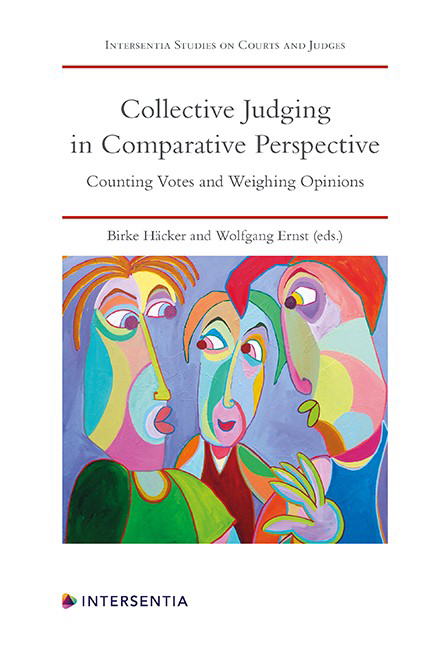Book contents
- Frontmatter
- Preface
- Contents
- List of Cases
- List of Contributors
- PART I DESIGNING COLLEGIATE COURTS’DECISION-MAKING PROCESSES
- PART II COLLEGIATE COURTS IN THE COMMON LAW TRADITION
- PART III COLLEGIATE COURTS IN THE EUROPEAN CIVIL LAW TRADITION
- PART IV COLLEGIATE COURTS IN A NON-EUROPEAN CIVIL LAW JURISDICTION: THE CASE OF JAPAN
- PART V SUPRANATIONAL AND INTERNATIONAL COLLEGIATE COURTS
- PART VI VOICES FROM THE AUDIENCE AND CLOSING REMARKS
- About the Editors
Chapter 2 - Collective Judging in the UK Supreme Court
Published online by Cambridge University Press: 09 February 2021
- Frontmatter
- Preface
- Contents
- List of Cases
- List of Contributors
- PART I DESIGNING COLLEGIATE COURTS’DECISION-MAKING PROCESSES
- PART II COLLEGIATE COURTS IN THE COMMON LAW TRADITION
- PART III COLLEGIATE COURTS IN THE EUROPEAN CIVIL LAW TRADITION
- PART IV COLLEGIATE COURTS IN A NON-EUROPEAN CIVIL LAW JURISDICTION: THE CASE OF JAPAN
- PART V SUPRANATIONAL AND INTERNATIONAL COLLEGIATE COURTS
- PART VI VOICES FROM THE AUDIENCE AND CLOSING REMARKS
- About the Editors
Summary
From the perspective of a lawyer from one of Europe ‘s civilian jurisdictions, the United Kingdom Supreme Court (UKSC) must appear rather curious. No formal rules govern the size of constitutions of the Court or their composition. The deliberative procedure is not laid down anywhere. There is not even any official explanation of how it is decided how many judgments will be written in a particular case, or who will write them. A German lawyer might be unsurprised to learn that there is no equivalent in English of the concept of the gesetzlicher Richter.
Like much in Britain, the Supreme Court is largely regulated by conventions and established practices rather than rules. It has to be understood in the light of history. It is the successor of the Appellate Committee of the House of Lords, and it has inherited much from its Parliamentary predecessor. But, as its creation provided an opportunity for change, the Supreme Court also exhibits some innovations.
THE HOUSE OF LORDS
A little history to begin with. From about the twelft h century, the High Court of Parliament exercised both legislative and judicial functions. Although separate common law courts later developed, Parliament remained the highest court of Royal justice. Its judicial functions came to be exercised by the House of Lords, after it emerged as a separate House in the late fourteenth century. Over time, it limited its jurisdiction to appeals from the lower courts, and the convention became established that only those members of the House with judicial experience would participate. In Victorian times, the procedures were reformed, and in 1876 legislation was enacted which allowed for the appointment to the House of professional salaried judges, often referred to as ‘Law Lords‘, specifically in order to deal with the final appeals in our legal system. They continued to hear appeals in the Chamber of the House of Lords until 1948, when noise caused by workmen repairing bomb damage to the Palace of Westminster forced the Law Lords to move to a committee room and form themselves into an Appellate Committee.
- Type
- Chapter
- Information
- Collective Judging in Comparative PerspectiveCounting Votes and Weighing Opinions, pp. 21 - 36Publisher: IntersentiaPrint publication year: 2020
- 1
- Cited by

